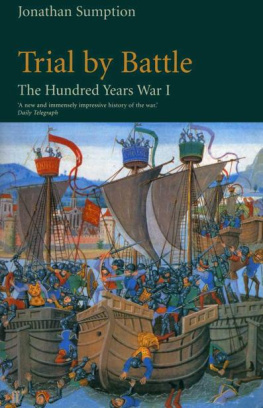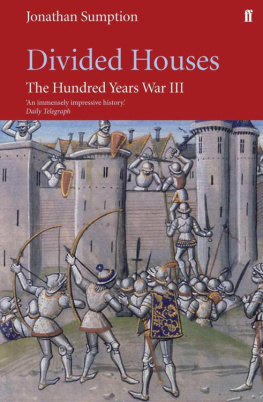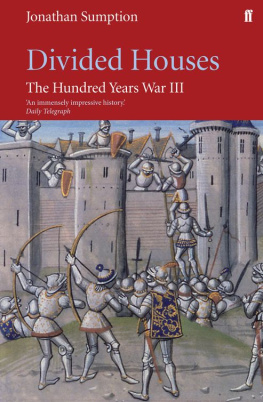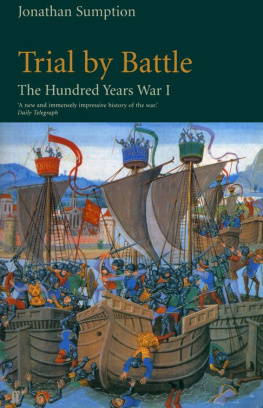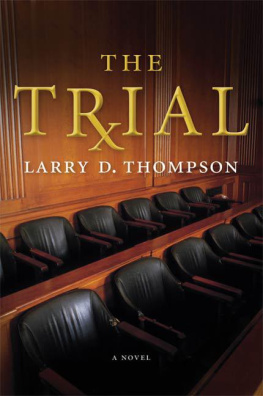Jonathan Sumption - Trial by Battle: The Hundred Years War, Vol. 1: Trial by Battle v. 1
Here you can read online Jonathan Sumption - Trial by Battle: The Hundred Years War, Vol. 1: Trial by Battle v. 1 full text of the book (entire story) in english for free. Download pdf and epub, get meaning, cover and reviews about this ebook. year: 1999, publisher: Faber and Faber, genre: Detective and thriller. Description of the work, (preface) as well as reviews are available. Best literature library LitArk.com created for fans of good reading and offers a wide selection of genres:
Romance novel
Science fiction
Adventure
Detective
Science
History
Home and family
Prose
Art
Politics
Computer
Non-fiction
Religion
Business
Children
Humor
Choose a favorite category and find really read worthwhile books. Enjoy immersion in the world of imagination, feel the emotions of the characters or learn something new for yourself, make an fascinating discovery.
- Book:Trial by Battle: The Hundred Years War, Vol. 1: Trial by Battle v. 1
- Author:
- Publisher:Faber and Faber
- Genre:
- Year:1999
- Rating:3 / 5
- Favourites:Add to favourites
- Your mark:
- 60
- 1
- 2
- 3
- 4
- 5
Trial by Battle: The Hundred Years War, Vol. 1: Trial by Battle v. 1: summary, description and annotation
We offer to read an annotation, description, summary or preface (depends on what the author of the book "Trial by Battle: The Hundred Years War, Vol. 1: Trial by Battle v. 1" wrote himself). If you haven't found the necessary information about the book — write in the comments, we will try to find it.
Jonathan Sumption: author's other books
Who wrote Trial by Battle: The Hundred Years War, Vol. 1: Trial by Battle v. 1? Find out the surname, the name of the author of the book and a list of all author's works by series.
Trial by Battle: The Hundred Years War, Vol. 1: Trial by Battle v. 1 — read online for free the complete book (whole text) full work
Below is the text of the book, divided by pages. System saving the place of the last page read, allows you to conveniently read the book "Trial by Battle: The Hundred Years War, Vol. 1: Trial by Battle v. 1" online for free, without having to search again every time where you left off. Put a bookmark, and you can go to the page where you finished reading at any time.
Font size:
Interval:
Bookmark:
HUNDRED YEARS
WAR
JONATHAN SUMPTION
VOLUME I
Trial by Battle

In the text
At the end
This book is intended to be the first volume of a history of the Hundred Years War, from its outbreak in the 1330s until the final expulsion of the English from France in the middle of the fifteenth century. This succession of destructive wars, separated by tense intervals of truce and by dishonest and impermanent treaties of peace, is one of the central events in the history of England and France, as well as in that of their neighbours who were successively drawn into it: Scotland, Germany, Italy and Spain. It laid the foundations of Frances national consciousness, even while destroying the prosperity and political pre-eminence which France had once enjoyed. It formed her institutions, creating, in the effort to control anarchy and defeat invasion, the germ of the absolute state of the seventeenth and eighteenth centuries. In England, it brought intense effort and suffering, a powerful tide of patriotism, great fortune succeeded by bankruptcy, disintegration and utter defeat.
I have written about England and France together, almost as if they were a single community engaged in a civil war as, in some respects, they were. I have tried to describe not only what happened, but why it happened and how it affected those who experienced it, whether they were close at hand, like the soldiers in the field and the inhabitants of countless burned-out villages and towns, or saw it at a distance, like the bankers, war contractors , bureaucrats and tax-payers, and the readers of newsletters and proclamations . But this book is a narrative. The sweep of events provides its framework. I make no apology for that. Although narrative history has not always been fashionable, the facts sometimes explain themselves better than any analysis of them could possibly do. Moreover, while there have been many valuable monographs on this or that aspect of the Hundred Years War, some fine histories of isolated incidents and campaigns, and one magnificent account of a single ruler (Charles V of France), no general history of the war has been written on the scale which it deserves. The best account remains that of the great French historian and anglophile, Edouard Perroy, written without access to books while the author was working with the French resistance in the later years of the Second World War. But in a single volume covering 120 years not even Perroy, with his profound knowledge of both English and French sources, could convey more than the outline of events, or penetrate behind the screen to observe the lives of men who never pretended to call the order of events but were only spectators and victims.
My approach has been to work primarily from the record sources of England and France, printed and unprinted. Later volumes will draw on the archives of Italy and Spain also. The chroniclers have an important but subordinate place. They have much to say about the character of the war and their anecdotes are often very revealing. They provide insights into the aristocratic mentality which the records can rarely offer. Depending upon the quality of their sources, they can be reliable guides to the course of events. But most of them are episodic, prejudiced, inaccurate and late. Froissart is particularly unreliable. Moreover, being essentially journalists, the chroniclers were also snobs. They rarely showed much interest in events in which no duke, earl or count participated. So, except for the tremendous battle at Sluys in 1340, they said almost nothing about the war at sea, which was waged by lowly men. Gascony was virtually ignored until 1345, when the first earl fought there. But the records throw a flood of light on these events, unselfconscious evidence, written by clerks who had no idea of recording history. I have identified in the notes the authorities for what I say in the text. But with rare exceptions I have not discussed conflicts of evidence or debated the divergent opinions of scholars. I have simply resolved the differences to my own satisfaction, and I hope to yours.
J.P.C.S.
Greenwich
May 1989
l.t. and l.p. stand respectively for livres tournois or pounds of Tours, and livres parisis or pounds of Paris. The pound sterling was generally worth five l.t. and four l.p. Unless otherwise stated livres are livres tournois.
CHAPTER I
Charles IV, the last Capetian King of France, died on 1 February 1328 at the royal manor of Vincennes, east of Paris. The burial of a king in the early fourteenth century was already an elaborate ceremony, marking off with a studied symbolism the end of a reign and the beginning of another. The body of the dead King, imperfectly preserved with vinegar and salt and aromatic spices, lay in state in Notre-Dame Cathedral, clothed in heavy robes of gold cloth and ermine, the crown at its head, the face exposed and the hands holding the regalia of office, the sceptre, ring and staff of justice as if in a macabre reversal of the coronation ceremony. On the following Friday, 5 February, the body was carried on an open bier to the mausoleum of the French monarchy at Saint-Denis, accompanied by a procession in which precedence assigned his exact place to every man. The Bishop of Paris, his fellow bishops, the chapter of Notre-Dame and the clergy of the city preceded it; the royal family and the principal noblemen followed behind; at the rear came the leaders of the rich citizenry of Paris dressed in black with large hoods covering their faces; and close around the bier the poor of the city for whom the funeral of a king was an occasion for the distribution of largesse, a formality which no royal will omitted.
The route from Notre-Dame to Saint-Denis passed through the streets of Paris for scarcely 2 miles before emerging into open country to the north. Yet the Paris of 1328, although it covered but a fraction of the area of the modern city, was the largest, most densely populated city of northern Europe and the richest. Within its walls and in the new suburbs to the north, more than 100,000 people lived, at a time when London probably had less than 40,000 inhabitants. Its citizens were packed into a dense mass of tall, narrow wood-frame houses, separated by a warren of irregular alleyways which Jean de Jandun from the calm of the university quarter on the south bank likened to the hairs of a multitude of heads, ears of corn piled up after a plentiful harvest, or leaves in a dense forest. carts, driven cattle, clanging bells and shouts of gare leau as slops fell into the street from upper windows. Only the proximity of the open country outside can have saved from perpetual epidemic a city which had no sewer until 1374 and only three public fountains, all of them north of the Seine, a place where the more fastidious emptied the contents of their latrines weekly into carts to be dumped outside the walls, where pigs, dogs and rats rooted among the piles of garbage, butchers slaughtered their animals in the streets and lepers wandered at large.
No city renewed itself naturally in the unhealthy conditions of the middle ages, and Paris had long drawn its expanding population from immigrants attracted by the wealth, fame and freedom of the capital. An increasingly bureaucratic monarchy had established its courts and record offices there. The great noblemen of the realm, the counts of Burgundy, Brittany, Flanders and Champagne, the princes of the royal family and the more important bishops and abbots visited the city on official business accompanied by crowds of servants and hangers-on, accommodating them in substantial mansions within the walls. Rapid fortunes were made by commodity speculators, bankers and food wholesalers, giving rise to stark contrasts of wealth and poverty, and supplying a market for the luxury trades for which Paris was famous throughout Europe: painters, jewellers, goldsmiths, furriers. A large community of Florentine and Sienese bankers had grown up in the mercantile quarter on the right bank of the Seine. On the left bank, the University attracted an unruly clerical underworld, several thousand strong. And beneath all these came the tide of salaried journeymen, domestic servants and mendicant poor, the ballast of every medieval city. Survival was not easy, and comfort rare.
Font size:
Interval:
Bookmark:
Similar books «Trial by Battle: The Hundred Years War, Vol. 1: Trial by Battle v. 1»
Look at similar books to Trial by Battle: The Hundred Years War, Vol. 1: Trial by Battle v. 1. We have selected literature similar in name and meaning in the hope of providing readers with more options to find new, interesting, not yet read works.
Discussion, reviews of the book Trial by Battle: The Hundred Years War, Vol. 1: Trial by Battle v. 1 and just readers' own opinions. Leave your comments, write what you think about the work, its meaning or the main characters. Specify what exactly you liked and what you didn't like, and why you think so.

